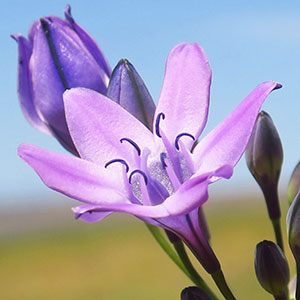Triteleia hendersonii
Triteleia bridgesii
Henderson's stars, Henderson's triteleia, yellow tiger-lily
Bridges' brodiaea, Bridges' triteleia
15–40 cm × 3–12 mm.
20–55 cm × 3–10 mm.
10–35 cm, smooth or slightly scabrous near base.
10–60 cm, smooth except sometimes scabrous near base.
perianth yellow or white, often tinged or fading blue, 18–26 mm, tube slenderly funnelform, moderately attenuate at base, 6–10 mm, lobes widely spreading, with conspicuous dark purple midvein, 12–16 mm, ca. twice as long as tube;
stamens attached at 1 level, nearly equal;
filaments narrowly subulate, 3–4 mm, apical appendages absent;
anthers blue or sometimes white, 1.5–2 mm;
ovary 1/2 as long as stipe;
pedicel 1.5–4 cm.
perianth lilac, bluish purple, pink, or reddish purple, 27–45 mm, tube strongly attenuate with slender base, 17–25 mm, hyaline vescicles present in tube, lobes abruptly spreading, 10–20 mm, shorter than tube;
stamens attached at 1 level, equal;
filaments triangular, widened toward base, 3–4 mm, apical appendages absent;
anthers bluish, 3.5–4.5 mm;
ovary 1/4–1/3 length of stipe;
pedicel 2–9 cm.
= 32.
= 16.
Triteleia hendersonii
Triteleia bridgesii
Triteleia hendersonii is common within its restricted range. The plants previously recognized as var. leachiae, or separately as T. leachiae, differ primarily in having a white perianth and are limited to Curry County, Oregon. Intermediates have been found, and further study of this variation is required to determine whether formal recognition of infraspecific taxa is warranted.
(Discussion copyrighted by Flora of North America; reprinted with permission.)
Triteleia bridgesii is similar to T. laxa and in herbarium specimens can be distinguished only by the stamens. However, in fresh flowers, the perianth lobes of T. bridgesii spread abruptly from the throat of the perianth tube, unlike those of T. laxa, and the flowers of T. bridgesii are erect, while those of T. laxa are oriented horizontally. Triteleia bridgesii flowers a month earlier than T. laxa where they both occur in the Sierra Nevada foothills. The flowers in specimens of T. bridgesii from Humboldt County are unusually long, which accounts for the wide ranges of measurements for the perianth.
(Discussion copyrighted by Flora of North America; reprinted with permission.)


